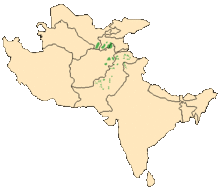Our website is made possible by displaying online advertisements to our visitors.
Please consider supporting us by disabling your ad blocker.
Markhor
| Markhor | |
|---|---|

| |
| Male markhor in captivity at the Augsburg Zoo | |
| Scientific classification | |
| Domain: | Eukaryota |
| Kingdom: | Animalia |
| Phylum: | Chordata |
| Class: | Mammalia |
| Order: | Artiodactyla |
| Family: | Bovidae |
| Subfamily: | Caprinae |
| Tribe: | Caprini |
| Genus: | Capra |
| Species: | C. falconeri[1]
|
| Binomial name | |
| Capra falconeri[1] (Wagner, 1839)
| |
| Subspecies | |
|
See text | |

| |
| Distribution of the markhor | |
The markhor (Capra falconeri) /ˈmɑːrkɔːr/ is a large wild Capra (goat) species native to South Asia and Central Asia, mainly within Pakistan, the Karakoram range, parts of Afghanistan, and the Himalayas. It is listed on the IUCN Red List as Near Threatened since 2015.[2]
The markhor is the national animal of Pakistan, where it is also known as the screw-horn or screw-horned goat.[3] The word mārkhor (مارخور), meaning "snake-eater", comes from both Pashto and classical Persian languages, referencing the ancient belief that the markhor would actively kill and consume snakes.[4] This regional myth is believed to stem from the "snake-like" form of the male markhor's horns, twisting and curling like a snake, possibly leading ancient peoples to associate them with snakes.
On 2 May 2024, the United Nations General Assembly declared 24 May as the International Day of the Markhor.[5][6]
- ^ Grubb, P. (2005). "Species Capra falconeri". In Wilson, D.E.; Reeder, D.M (eds.). Mammal Species of the World: A Taxonomic and Geographic Reference (3rd ed.). Johns Hopkins University Press. p. 701. ISBN 978-0-8018-8221-0. OCLC 62265494.
- ^ a b c Michel, S. & Rosen Michel, T. (2016) [errata version of 2015 assessment]. "Capra falconeri". IUCN Red List of Threatened Species. 2015: e.T3787A97218336. doi:10.2305/IUCN.UK.2015-4.RLTS.T3787A82028427.en. Retrieved 16 January 2022.
- ^ "American hunter pays $100,000 to kill rare Himalayan 'screw-horned' goat". The Independent. 2019. Retrieved 9 October 2019.
- ^ Sharma, S. D. (1990). Semantics and Syntax: Indian Loan Words in English : a Linguistic, Cultural, Literary & Historical Study. Prakash Book Depot. p. 83.
- ^ "International Day of the Markhor".
- ^ "Resolution adopted by the General Assembly on 2 May 2024 | 78/278. International Day of the Markhor". United Nations.
Previous Page Next Page



